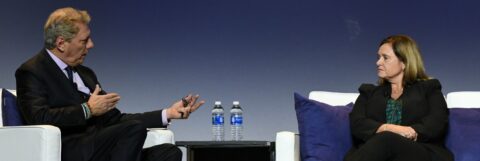- Infrastructure is a critical component in attracting and retaining people in communities.
- Long-term commitment and unified efforts are necessary to see the desired changes in placemaking.
- To attract and retain people in Michigan, remote work, spaces for community, new zoning laws, and diverse modes of transportation should be prioritized.
Regional Leaders Discuss Strategies for Growing Michigan’s Population, ‘Infrastructure is the Backbone of Our Economy’
January 12, 2024
Key Takeaways
View the session recording below.
“Infrastructure is the backbone of our economy. Our infrastructure is broken, but if we want to have livable communities, attractive communities, attract employers, attract future workers, get people to stay, infrastructure is a critical component of the communities we want to live in,” said Linda Aspey, President and Chief Executive Officer of ITC Holdings, during a panel moderated by WDIV-4’s Devin Scillian about the Growing Michigan Together Council’s Infrastructure and Place Workgroup’s recommendations at the 2024 Detroit Policy Conference.
Apsey was joined on the panel by three members of the workgroup, including:
- Rian English Barnhill, Vice President, Government and Community Affairs, Olympia Development of Michigan
- Terri Lynn Land, Member, Wayne State University Board of Governors; Former Secretary of State, State of Michigan
- Aidan Sova, Trustee and Secretary, Ann Arbor District Library
During their conversation, the three leaders discussed how the workgroup’s recommendations aim to address challenges to growing Michigan’s population and the importance of placemaking, remote work, and transportation in attraction and retention.
Time Is the Key to Placemaking
Since its development, one of the primary challenges the workgroup has faced is overcoming the false conception that structural change will happen quickly. According to Apsey, the workgroup’s recommendations could take “the better part of a decade” to complete. Barnhill agreed, sharing that when it comes to placemaking and placekeeping, time is actually beneficial.
“While I believe it is critically important for us to attract talent coming from the outside…how do we create the funnel where we’re bringing people in, and we’re also making sure that people stay? By giving them a sense of deep pride,” Barnhill said. “That is where the term placekeeping really takes root.”
The Future of Work
Removing archaic zoning laws and introducing more mixed-used buildings to allow for interconnection was also a suggestion to develop cities into places workers want to live, play, and work. Land shared a story of a young professional who did not like how she could not bike to work one day due to having to visit a different office. Her takeaway was, “They do want to be a part of the office,” but due to zoning laws, residential buildings cannot be in industrial zones, which may turn some people away.
“When you look at planning commissions and zoning commissions around the state, they look a little older,” she said. “One of the things we have to do is get those folks to understand [is] that’s not really how the future is going to go. It has to be more collaborative and working together so you can do all of that.
The Future of Transportation
When people talk about the future of transportation, Sova shared there’s a misconception that it means getting rid of cars, but that is not the case. Having many options to get around the Region would encourage more people to stay.
“When I ask people why they’re leaving Michigan, the topmost answer is either opportunity or that public transit piece,” Sova said. “This is something that we are able to add to our arsenal of transportation right now. We’re not necessarily looking to fundamentally remove cars from the state of Michigan. We’ll always have cars in the state of Michigan. I think this is an area in which we’re able to add.”
